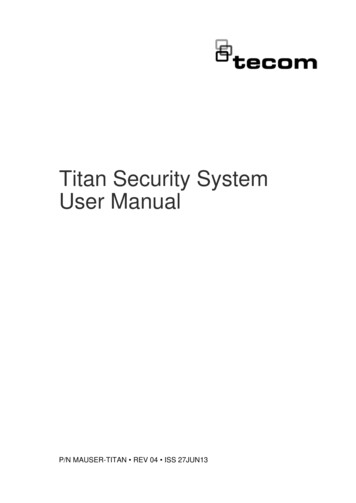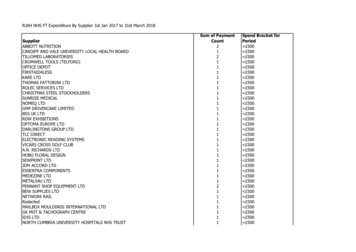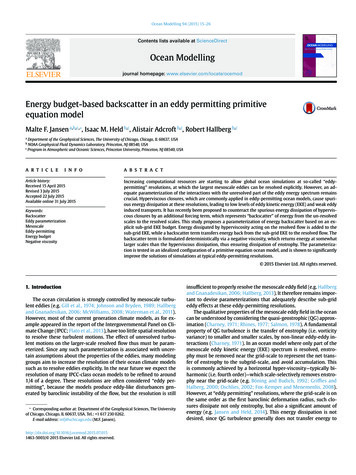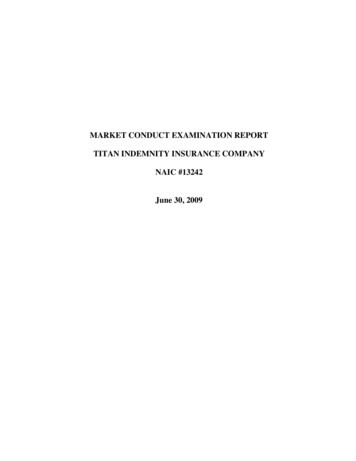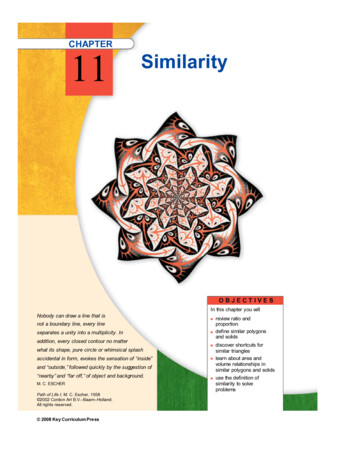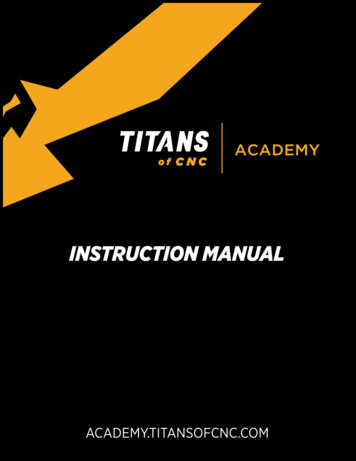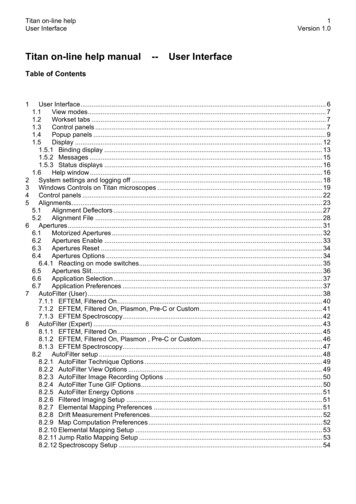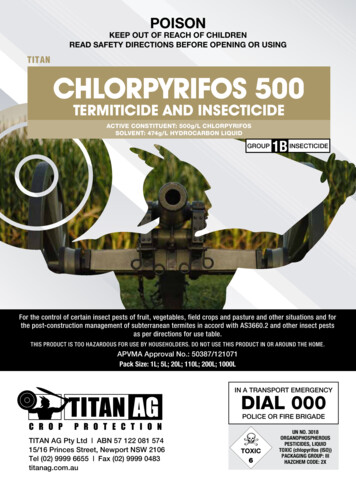
Transcription
POISONKEEP OUT OF REACH OF CHILDRENREAD SAFETY DIRECTIONS BEFORE OPENING OR USINGTITANCHLORPYRIFOS 500TERMITICIDE AND INSECTICIDEACTIVE CONSTITUENT: 500g/L CHLORPYRIFOSSOLVENT: 474g/L HYDROCARBON LIQUIDGROUP1B INSECTICIDEFor the control of certain insect pests of fruit, vegetables, field crops and pasture and other situations and forthe post-construction management of subterranean termites in accord with AS3660.2 and other insect pestsas per directions for use table.THIS PRODUCT IS TOO HAZARDOUS FOR USE BY HOUSEHOLDERS. DO NOT USE THIS PRODUCT IN OR AROUND THE HOME.APVMA Approval No.: 50387/121071Pack Size: 1L; 5L; 20L; 110L; 200L; 1000LIN A TRANSPORT EMERGENCYDIAL 000POLICE OR FIRE BRIGADETITAN AG Pty Ltd ABN 57 122 081 57415/16 Princes Street, Newport NSW 2106Tel (02) 9999 6655 Fax (02) 9999 0483titanag.com.auUN NO. 3018ORGANOPHOSPHEROUSPESTICIDES, LIQUIDTOXIC (chlopyrifos (ISO))PACKAGING GROUP: IIIHAZCHEM CODE: 2X
DIRECTIONS FOR USEMANAGEMENT OF SUBTERRANEAN TERMITES (All States, except Tasmania)Restraints: DO NOT apply to soils if excessively wet, immediately after heavy rain or if heavy rains are expected within 48 hours to avoid run-off of chemical.DO NOT use at less than indicated label rates.DO NOT use in cavity walls, except for direct treatment of nest.DO NOT use on alkaline soils in SA (use on neutral or acidic soils only) or on dolomite based sub-slab bedding material.DO NOT use Horizontal barriers around homes, in residential areas, public spaces or in publicly accessible commercial areas.RATES OF APPLICATIONImportant: TITAN Chlorpyrifos 500 Termiticide and Insecticide should be used as part of an overall termite management program as detailed in AustralianStandard Series AS3660. A great deal of care is required to understand construction details of the building and to apply the product in a manner which ensures acomplete chemical soil barrier. Where necessary, the barrier may need to be re-applied under the building. Application equipment must be fitted with a flow meterand pressure regulator on the application device. The purpose of a chemical soil barrier is to impede and discourage concealed termite entry into a structure.Barriers may still be bridged by termites, but their entry can then be more easily detected during routine inspections. If a barrier is not complete or breached, thenconcealed termite entry may occur. It is often not possible to form a complete barrier around existing structures in which case other termite management optionsand/or more frequent inspections will also need to be considered.SITUATIONRATECRITICAL COMMENTSInstalling a chemicalHorizontal Barriers:Horizontal Barriers: Use 100mL TITAN Chlorpyrifos 500 Termiticide and Insecticide per 5L water and applysoil barrier around and 100mL/m2the mixture (emulsion) at a rate of 5L/m2. Not to be used around homes, in residential areas, or in publicunder buildingsspaces or in publicly accessible commercial areas.Vertical Barriers:Vertical Barriers: Use 2L of TITAN Chlorpyrifos 500 Termiticide and Insecticide per 100L of water and apply2L/m3the mixture at a rate of 100L/m3.See APPLICATION VOLUME section in GENERAL INSTRUCTIONS for further information.200mL/10L is equivalent to a 1% active ingredient emulsion.See Service requirement in GENERAL INSTRUCTIONS for expected barrier life.Horizontal Barriers:Installing a chemicalThis is an optional high rate for use north of the Tropic of Capricorn, or where M. darwiniensis is a concern.soil barrier around and 200mL/m2Horizontal Barriers: Not to be used around homes, in residential areas, or in public spaces or in publiclyunder buildings north of Vertical Barriers:accessible commercial areas. Use 200mL of TITAN Chlorpyrifos 500 Termiticide and Insecticide per 5L ofthe Tropic of Capricorn 4L/m3water and apply the mixture (emulsion) at a rate of 5L/m2.or where MastotermesVertical Barriers: Use 4L of TITAN Chlorpyrifos 500 Termiticide and Insecticide per 100L of water and applydarwiniensis is athe mixture at a rate of 100L/m3.concernSee APPLICATION VOLUME section in GENERAL INSTRUCTIONS for further information.4L/100L is equivalent to a 2% active ingredient emulsion.See Service requirement in GENERAL INSTRUCTIONS for expected barrier life.200mL/10L of water or Trench (preferred) or rod and puddle-treat backfill, ensuring a complete and continuous treated soil barrier isInstalling a chemicalprovided around the pole or post, to a minimum depth of 300mm and minimum width of 150mm. Use 100Lsoil barrier around new creosoteof emulsion per m3 of soil. In addition, infested poles may be drilled near ground level and the cavity floodedand existing poles,e.g. transmission andwith the emulsion. This allows seepage to form a treated soil barrier.building poles, fenceNote: A 50mm gap between fence palings and soil will reduce termite attack and fungal decay. Only soil inposts and palingscontact with palings should be treated. Replenishment is recommended within 2 years north of the Tropic of Capricorn and 5 years in other areas. If the barrier is disturbed, or rain falls immediately after application, retreat to restore continuity andcompleteness of the barrier.Refer to Australian Standard Series AS 3660.Treatment of termite100mL/10L of waterOnce the nest or colony has been located it should be broken open and flooded with emulsion. This includesnest or colonynests located in trees. When treating trees, addition of a wetting agent is suggested.Refer to Australian Standard Series AS 3660.NOT TO BE USED FOR ANY PURPOSE, OR IN ANY MANNER, CONTRARY TO THIS LABEL UNLESS AUTHORISED UNDER APPROPRIATELEGISLATIONAPPLICATION INSTRUCTIONSAPPLICATION EQUIPMENTHand SprayingFor hand spraying use a rose head shrouded nozzle operated at 170kPa, witha flow meter and pressure regulator fitted to the hand-piece.Treatment Beneath Concrete Slabs or Sealed AreasWhere it is not possible or practical to remove the slab to allow directapplication to the soil, use a sub-slab injector fitted with multi-directional tip(eg. a B&G or similar system) with a 5 degree upward angle (eg. 3 way or 4way) operated at 170kPa. Ensure a strong seal with the top of the drill hole toavoid leakage. For the best distribution, the injector needs to be held vertically,at right angles to the slab, and rotated during the application through 90degrees (if using a 4 way dispersion tip), or through 120 degrees (for a 3 waydispersion tip).Injection into SoilWhere it is not possible or practicable to trench the soil; use a soil rod with a 3or 4 way multi-directional tip (B&G, or similar) operated at 170kPa. The 4 waytip needs to be rotated during the application through 90 degrees and the 3way tip through 120 degrees.APPLICATION VOLUMETo compensate for impervious soils such as heavy clay where application of5L/m2 would cause run-off, it may be necessary to apply a volume of emulsionless than 5L/m2. When reducing the total volume of emulsion used, increasethe concentration accordingly to match the label rate by mixing the requiredamount of TITAN Chlorpyrifos 500 Termiticide and Insecticide per m2 in alesser volume of water.DO NOT use emulsion volumes less than 2L for every square metre to betreated.Note: Use of emulsion volumes other than the recommended 5L/m2 is onlypermitted when installing chemical barriers in exposed soil. It is not permittedwhen injecting through the slab or into sealed areas.Existing Structures(a) Strategic Drilling Through Slab or Sealed AreasFor treatment of slabs when termites are entering the building through theslab, where reticulation systems do not exist, slab drilling and injection willbe required. In most cases, unless there is a known severe termite hazard,grid drilling of the slab is not required. Any such need is to be determined bya licensed Pest Manager. Treatment needs to be made around the inside of allexterior walls to complete a termite barrier, along both sides of interior wallTITAN CHLORPYRIFOS 500 TERMITICIDE AND INSECTICIDE l PAGE 2 OF13
partitions, around plumbing/electrical or piping entry points and along majorcracks or expansion joints. When treating along major cracks or expansionjoints it is recommended that holes are drilled alternately on either side of thecrack at the recommended drill hole spacings.For a sand base or sandy soil, apply through a row of holes drilled no morethan 300mm apart and 100-200mm out from the wall, crack or pipe. For aclay base, apply through a row of holes drilled 150mm apart and 100mm fromthe wall, crack or pipe. Apply 10L of emulsion per linear metre and ensure theholes are securely plugged after treatment.(b) External BarriersAn external barrier should be installed around the perimeter of the building andshould circumference all pipes and service facilities. External barriers shouldbe created by using either a vertical or horizontal barrier, as determined bythe building construction type and adjoining ground level. An external barrieris an essential part of the treatment when relying on a chemical soil barrier toprovide the full termite management system as per AS3660.An external horizontal barrier is only required when prevention of concealedvertical access by termites is necessary at the perimeter (eg, when groundlevel is equal to the top of a slab, where the slab is also a barrier to concealedtermite movement into the building). A vertical barrier is required whenprevention of concealed horizontal access is necessary (eg, where groundlevel is higher than building material vulnerable to concealed horizontal entryby termites).(i) Horizontal Barrier: DO NOT use horizontal barriers around homesor in residential areas, or in public spaces and publicly accessiblecommercial areas. Use a rose head shower nozzle operated at170kPa to apply the required rate of 1.5L of the correctly dilutedTITAN Chlorpyrifos 500 Termiticide and Insecticide per lineal metreDIRECTIONS FOR USE – AS AN INSECTICIDEFRUIT AND VEGETABLESCROPSINSECTSTATEBanana Scab MothQLD onlyBanana Weevil Borer QLD, NSW,ACT onlyCaterpillarsAerial: 1 or 2Lin a minimum of10L waterNot applicableNSW, ACTonlyCarrotsLightbrown AppleMothCassavaCutwormQLD onlyCole BroccoliCabbage Moth,Cabbage WhiteButterfly, CabbageAphid, ClusterCaterpillar, CabbageCluster CaterpillarCorn Earworm,Native BudwormNSW, ACT,VIC, TAS, SA,WA onlyRod Spacings:CLAY LOAMS200mmSANDS300mmInsert the rod to the foundation foot as close as possible to the house wallensuring the chemical is applied during insertion and withdrawal. (SeeAPPLICATION EQUIPMENT Section, Injection into Soil.)(c) Suspended FloorsInstall horizontal and vertical barriers as specified in Australian StandardSeries AS3660 to adjoin all substructure walls, stumps, piers, pipes andwastes using the techniques described for external barriers around concreteslabs. (See Existing Structures section.)VOL/100LWATER200mLApply aminimum of500L water/haWHPCRITICAL COMMENTS14 daysApply from the first appearance of flower bell andrepeat as populations indicate until fingers areexposed. Use high rate with onset of wet weatherand/or heavy insect pressure.Note: Burning of young fruit may occur under poordrying conditions.After removal of trash, apply 500-700mL of spraydepending on butt size, to the lower 30cm of thebutt and to the surrounding soil within a radiusof 30cm, ensuring thorough coverage of butt andsuckers.Sub-tropical areas: Use high rate for annualcontrol of borers.Tropical areas: Use high rate in SeptemberNovember for initial spray and a follow-up withlow rate in February-April should insect presencewarrant a second application.Apply from the first appearance of flower bell andrepeat as populations indicate until fingers areexposed. Use as ground application only, do notapply by air.Apply when moths are first detected. Repeatat the higher rate if there is a re-occurrence ofinfestation.Apply to seedlings and soil at base of seedlings,when Cutworm activity is observed.Spray at 10 to 14 day intervals. Use high rateunder heavy pest pressure.Large plants: Use 1000L of spray/ha. To improvespray coverage add non-ionic wetting agents asrecommended.1 or 1.8L200mL500 or 700mLQLD onlyHEAVY CLAY SANDS150mmRATEVOL/HABananas(150mm wide) to soil loosened to a depth of approximately 80mm (seeAPPLICATION VOLUME section).(ii) Vertical Barrier: The vertical barrier should be at least 150mm wideand should reach down to 50mm below the top of the footings. Toachieve this, trench to the top of the footings, and where this is notpossible, a combination of trenching (preferably at least 300mm deep)and rodding into the base of the trench may be necessary. ApplyTITAN Chlorpyrifos 500 Termiticide and Insecticide emulsion at 100Lper cubic metre of backfill soil, this equates to 1.5L of emulsion/linear metre of a trench 150mm wide and 100mm deep. Where therequired vertical barrier is deeper than 100mm, ensure the same rateof application for the extra volume of soil. Use a rose head showernozzle operated at 170kPa to flood the base of the open trench andalso to treat the backfill soil as it is replaced into the trench to ensureeven distribution. Where rodding is necessary, rod before the trench istreated using the spacings in the following table.Not applicableNotapplicable1.5 or 2L150 or 200mL5 days1.5L150mL700mLTITAN CHLORPYRIFOS 500 TERMITICIDE AND INSECTICIDE l PAGE 3 OF13Apply when pests first appear.Large plants: Use 1000L of spray/ha.
CROPSINSECTSTATERATEVOL/HACole Broccoli– continuedCorn EarwormNSW, ACT,VIC, SA, WAonlyNative BudwormNSW, ACT,VIC, TAS, SA,WA onlyWinglessGrasshopperNSW, ACT,VIC, TAS, SAonlyNSW, ACTonlyRedlegged EarthMite, Blue Oat MiteCabbage,CauliflowerAfrican Black BeetleCucurbitsWhite FliesGingerCutwormQld onlyKiwifruitCommon Armyworm,Southern Armyworm,Lightbrown AppleMothPineapple MealyBug, AntsNSW, ACT,VIC, WA, SA,TAS, QLDonlyQLD onlyPineapplesNSW, ACTonlyWhite GrubsPotatoesAfrican Black BeetleNSW, ACT,WA only1.5 or 2LVOL/100LWATER150 or 200mL500mL50mL140 or 300mLNot applicable2L(Boom spray)WHPCRITICAL COMMENTS5 daysApply at 10 to 14 day intervals. Use high rateunder heavy pest pressure.Large plants: Use 1000L of spray/ha.Apply at 10 day intervals commencing when pestsfirst appear.Apply at 7 day intervals under heavy pestpressure.Large plants: Use 1000L/ha.Spray areas of crop infested with grasshoppers.Also apply as a barrier across the line of advance,when grasshoppers are invading the crop.Use higher rate for severe infestations. Headlandsand vegetation surrounding the crop may alsoneed to be sprayed.Boom spray: Apply in 500-1000L of water/ha ator soon after planting as a 10-15cm band spray.Drench: Apply 100mL of diluted spray to baseof each plant. Treat as soon as the first signsof infestation are observed. Note: If attack isprolonged, follow up boom spray or drenchtreatment may be necessary.Apply when pest is first detected. If requiredrepeat applications every 10-14 days.Apply when pest population is evident fromdamage to the primary shoot at or below ground,or to the first leaf during growth.Apply at green tip at least 10 days after dormantlime sulphur application and pre-blossom.DO NOT apply post-blossom.300mL (drench) 5 daysNot applicable50mL700-900mLNot applicable1L50mLNot applicable50 or 100mL5LNot applicable3 or 6LNot applicableNotapplicableNot ble14 daysNotapplicable900mLWhitefringed WeevilWirewormNSW, ACT,VIC, WA onlyWA, NSW,ACT onlyVIC onlySilver BeetRedlegged EarthMite, Blue Oat MiteNSW, ACTonlyStrawberriesField Crickets, Mole QLD onlyCricketsTomatoesWinglessGrasshopperNSW, ACT,VIC, TAS, SAonly6L1L6L140 or 300mL100mL/10kgbran bait/ha500mLTITAN CHLORPYRIFOS 500 TERMITICIDE AND INSECTICIDE l PAGE 4 OF13Apply when pests are first seen and repeat at 90day intervals or as necessary. Use a minimum of3000L of spray/ha. Use higher rate under heavypest pressure.Apply as a pre-plant spray to a freshly cultivatedsoil surface. Incorporate immediately by rotaryhoeing to a depth of 10-20cm.Apply the spray to the soil immediately priorto planting, ensuring thorough immediateincorporation to a depth of 15cm. Use higher rateunder heavy pest pressure.Apply as a second spray as bands on either side ofplants at final hilling-up. Ensure good incorporationof the spray immediately into the soil in the hill.Apply pre-plant and incorporate into the soilimmediately after application.Apply at hilling-up or 7 weeks after planting as afollow-up to preplant incorporation.Apply as a band spray to the soil surfaceincorporating immediately. Use before planting inareas where wireworms are a known problem.Use higher rate for severe infestations. Headlandsand vegetation surrounding the crop may alsoneed to be treated.Apply in recently ratooned strawberry patchesor newly planted runners when damage or pestpopulations indicate. Broadcast, preferably in thelate afternoon, to base of plants and inter-rowspace. See General Instructions on preparation ofbran baits.Spray areas of crop infested with grasshoppers.Also apply as a barrier across the line of advance,when grasshoppers are invading the crop.
CROPSINSECTSTATERATEVOL/HATomatoes– continuedWireworm, FalseWirewormQLD only5L/ha sprayedAfrican Black BeetleNSW, ACTonly2L(Boom Spray)300mL (Drench)1.5 or 2L150 or 200mLTomato GrubsVegetablesincludingAsparagus,Beans, Beetroot,Broccoli,Brussels sprouts,Cabbage,Cauliflower,Capsicum,Carrot, Eelery,Eggplant, Onion,Peas, Potato,Radish, Rhubarb,Shallot, SweetPotato, Tomato,TurnipApples, PearsVOL/100LWATERNot applicableQLD, NSW,ACT, VIC, WAonlyNative BudwormTAS onlyGreen Vegetable Bug TAS, SA, WAonlyGreen Peach Aphid QLD, VIC,TAS, SA, WAonlyWinglessNSW, ACT,GrasshopperVIC, TAS onlyCutwormALL STATESField Crickets, MoleCricketsVegetable WeevilQLD onlySan Jose ScaleQLD, NSW,ACT, SA, WAonlyNSW, ACTonlyWHPCRITICAL COMMENTSNotapplicableApply as a band at least 10cm wide into the openfurrow at planting. Spray the entire furrow widthusing a nozzle directly behind the planting tine.Use a minimum spray volume of 20L/ha.See General Instructions on soil application.Boom spray: Apply in 500-1000L of water/ha ator soon after planting as a 10-15cm band spray.Drench: Apply 100mL of diluted spray to base ofeach plant. Treat as soon as first sign of infestationis noticed. Note: If attack is prolonged, followup boom spray or drench treatment may benecessary.Spray on 7 to 10 day schedule commencingat flowering. Use high rate under heavy pestpressure.3 daysSpray at first sign of bug activity. Use higher rateunder heavy pest pressure.Spray when aphids are seen.Large plants: Use 1000L/ha.1L100mL500mL50mL700mL70mL100mL/10kgbran bait/ha800mLNot applicableNot applicable100mL14 days(2% misciblewinter oil maybe added to thedormant spray)Tomatoes:3 daysCole crops:5 daysAsparagus,celery: 14daysWoolly AphidAvocadoWinglessGrasshopperNSW, ACTonly500mL50mLAvocado LeafrollerQLD only1 or 2L50 or 100mLIvy LeafrollerNSW, ACTonlyLatania Scale,Hairy Caterpillars,LightbrownApple Moth, RedShouldered LeafBeetleTITAN CHLORPYRIFOS 500 TERMITICIDE AND INSECTICIDE l PAGE 5 OF137 daysSpray areas of crop infested with grasshoppers.Also apply as a barrier across the line of advance,when grasshoppers are invading the crop.Apply immediately infestation is observed.Increase concentration to compensate ifapplication is below 1000L/ha. Spray should coversoil out to at least 20cm on both sides of row crop.Apply as pest populations indicate. See GeneralInstructions on preparation of bran baits.Apply immediately infestation is observed. Applyas a band over the young plants and adjacent soilalong the row. One treatment should be sufficientif plants are sprayed at the seedling stage or soonafterwards.Dormant period: Apply as late as possibleensuring thorough coverage of all branches.Seasonal period: Apply to coincide withcrawler activity in mid-late November and lateras necessary. Ensure thorough coverage of allbranches, foliage and fruit.Apply when infestation build-up is first noticedensuring thorough coverage.Apply to areas of crop infested with grasshoppers.Also apply as a barrier across the line of advance,when grasshoppers are invading the crop.Use this rate in tank mix with 1L/ha (500mL/100Lof water) of dichlorvos (500g/L). For the lowvolume spray equipment use L/ha rate. Apply atfirst sign of pest activity before larvae move tofruit. Use higher rate when populations are high.Apply at first sign of pest activity before larvaemove to fruit. Use higher rate when populationsare high. For low volume spray equipment use L/ha rate.Apply when populations indicate treatment isrequired. Spots pray affected trees only. Repeatas necessary. Use higher rate when populationsare high.
CROPSINSECTSTATERATEVOL/HAWHPCRITICAL COMMENTS14 daysApply during November-March period. Two spraysmay be required under conditions of heavy scaleinfestation. Apply with high volume sprayer topoint of run-off.Note: DO NOT use on citrus in areas whereintegrated control programmes are in operation.Citrus, PomeFruitsWinglessgrasshopperVIC, TAS, SAonly500mLVOL/100LWATER100mL aloneor 50mL 1L misciblesummerspraying oil100mL aloneor 100mL 1L misciblesummerspraying oil50mLGrapevinesLightbrown AppleMothGrapevine MothGrapevine ScaleALL STATES500mL50mLQLD, NSW,ACT, TAS, SA,WA onlyNot applicableCommon Armyworm,Southern Armyworm,Lightbrown AppleMothCommon MangoScaleQLD, NSW,ACT, VIC, TAS,SA, WA,only1L100mL aloneor 50mL 1Lmiscible winteroil50mLQLD onlyNot applicable100mL21 daysEuropean EarwigNSW, ACTonly2L100mL14 daysCitrusCalifornia Red ScaleNSW, ACT,VIC, WA, SA,TAS onlyNot applicableQLD onlyKiwifruit –trellisedMangoStonefruitTomatoes –trellisedSan Jose ScaleQLD, NSW,ACT, WAONLYWinglessGrasshopperNSW, ACT,VIC, TAS, SAonlyQLD onlyWireworm, FalseWirewormAfrican Black BeetleTomato GrubsNSW, ACTonlyQLD, NSW,ACT, VIC, WAonlyNative BudwormTAS onlyGreen Vegetable Bug TAS, SA, WAonly200mL 250mLsunflower oil/5kg crackedwheat orcrackedsorghum baitNot applicableSpray areas of crop infested with grasshoppers.Also apply as a barrier across the line of advance,when grasshoppers are invading the crop.Apply initial spray just after berry set (earlyOctober). Later schedule sprays should be madeas required.Apply as a dormant spray, post-pruning (July).Apply at green tip at least 10 days after dormantlime sulphur application and pre-blossom. DO NOTapply post-blossom.100mL(2% misciblewinter oil maybe added to thedormant spray)500mL50mL5L/ha sprayedNot applicable3 daysNotapplicable2L (Boom spray) 300mL (drench)1.5 or 2L150 or 200mLTITAN CHLORPYRIFOS 500 TERMITICIDE AND INSECTICIDE l PAGE 6 OF133 daysApply to coincide with crawler activity. Ensurethorough coverage of all branches, foliage andfruit.Spray application: Apply in a minimum of 2000L/ha in spring. If lower volume used, increaseconcentration to apply 2L of product/ha.Bait application: Apply 5kg of bait/ha in springby fertiliser spreader. See General Instructions onpreparation of cracked wheat or cracked sorghumbait.Dormant period: Apply as late as possibleensuring thorough coverage of all branches.Seasonal period: Apply to coincide with crawleractivity in mid-late November and later ifnecessary. Ensure thorough coverage of allbranches, foliage and fruit.Note: Some fruit marking may occur if highvolume spraying is carried out under hot, dryconditions.Spray areas of crop infested with grasshoppers.Also apply as a barrier across the line of advance,when grasshoppers are invading the crop.Apply as a band at least 10cm wide into the openfurrow at planting. Spray the entire furrow widthusing a nozzle directly behind the planting tine.Use a minimum spray volume of 20L/ha.See General Instructions on soil application.Boom spray: Apply in 500-1000L of water/ha ator soon after planting as a 10-15cm band spray.Drench: Apply 100mL of diluted spray to base ofeach plant. Treat as soon as first sign of infestationis noticed.Note: If attack is prolonged, follow-up boom sprayor drench treatment may be necessary.Spray on 7 to 10 day schedule commencingat flowering. Use high rate under heavy pestpressure.Spray at first sign of bug activity. Use higher rateunder heavy pest pressure.
CROPSINSECTSTATERATEVOL/HATomatoes –Green Peach Aphidtrellised– continuedFIELD CROPS AND PASTURECROPSINSECTCanolaWireworm, False(rapeseed)WirewormQLD, VIC,TAS, SA, WAonlySTATEQLD onlyCereals, Pasture, Southern Armyworm, ALL STATESforage cropsCommon ArmywormCerealsPasture WebwormCereals, pasture, Cutwormyoung plants ofoil seeds1LVOL/HA1 or 1.5L/ha700 or 900mLNSW, ACT,VIC, TAS, SAonlyWA only700mLQLD, NSW,ACT, TAS, WAonlyVIC onlySA only900mL in aminimum of100L water700mL in aminimum of100L waterCereals, pasture, Cutworm (Agrotisoil seedsmunda and A. infusa)CerealsCereal CurculioSA, WA ONLY120mL/100kgseed1.25 or 1.5LAustralian PlagueLocustVIC only560mL350mLSA onlyQLD, NSW,ACT, VIC, WAonly560mL350mLBlue Oat MiteRedlegged EarthMiteLucerne FleaCereals, pasture, WinglessoilseedsGrasshopperWHPNot applicableCereals:10 daysGrazing:2 daysNot applicableCereals:10 daysGrazing:2 daysQLD onlyALL STATESNSW, ACT,VIC, WA, TAS,SA onlyNSW, ACT,VIC, TAS, SAonlyWHPCRITICAL COMMENTS3 daysSpray when aphids are seen.Large plants: Use 1000L/ha.CRITICAL COMMENTSApply as a broadcast application. Use higher rate with extremepopulation numbers.See General Instructions on soil application.Spray over total crop area when infestation is widespread. Whenpests are moving as an “army”, treat a broad strip over and inadvance of the infestation.Late stage instar: Use higher rate when larvae 3cm in length.Apply follow-up as required.Spray at first sign of damage. Apply with ground-rig boom ormister or by air.Pre-plant: Apply with the label rate of an approved tillageherbicide to foliage prior to any cultivation.Post-emergence: Apply at first sign of damage. Apply withground-rig boom or mister or by air.Apply immediately infestation is observed. Apply follow-uptreatments as required.300mLCereals, pasture, Spur-throated Locust QLD, NSW,forage cropsACT, VIC, WAONLYMigratory LocustVOL/100LWATER100mL140mL70mL500mLTITAN CHLORPYRIFOS 500 TERMITICIDE AND INSECTICIDE l PAGE 7 OF13Apply as a seed dressing just prior to sowing through anaccurately calibrated applicator.Note: A sowing rate of 95kg/ha (min.) is necessary to ensureeconomic responses are achieved.Spray areas of crop or pasture infested with locusts. Apply sprayto trees or roosting sites to control swarming adult locusts.Late stage hoppers and adults: Use higher rate.Adults: Spray areas of crop or pasture infested with locusts.Hoppers: Spray a swath in advance of marching band and thenspray along the dense marching front. Continue spraying until allhoppers have been contactedAdults: Spray areas of crop or pasture infested with locusts.Hoppers: Spray a swath in advance of marching band and thenspray along the dense marching front. Continue spraying until allhoppers have been contacted.Spray areas of crop, trees and roosting sites infested withlocusts.Spray when pests appear in large numbers, 3-6 weeks afterautumn rains. Re-spray as necessary. Avoid spraying when pestsare sheltering. Spray when at least 2.5cm cover of pasture orcrop is present. DO NOT spray if rain is imminent.Spray area of crop or pasture infested with grasshoppers. Applyalso as a barrier across the line of advance, when grasshoppersare invading the crop.
CROPSField Peas,Broad Beans,Chickpeas,Lupins, Lucerne,Lucernepastures andClover seedcrops, Rapeseed,Linseed,Safflower,Wheat, Oats,Barley, Rye,TriticaleImprovedannual pastures,establishingperennialpasturesCotton(young plants)INSECTBlue Oat Mite,Redlegged EarthMiteSTATENSW, ACTonlyVOL/HA140-300mLWHPCRITICAL COMMENTSApply as a ground spray immediately prior to seedlingemergence using sufficient water to give good coverage. Ifmite activity is severe, also spray headlands and surroundingvegetation prior to seedling emergence.CutwormQLD, NSW,ACT onlySouthern Armyworm, QLD, NSW,Common armyworm ACT only4 weeks(harvest)4 weeks(grazing)Apply immediately infestation is observed. Apply follow-uptreatments as required.Cotton900mL in aminimum of100L water700mL or900mLPink SpottedBollworm MothSpur-throatedLocustsLucerne andmedics inpasture andforage crops1.25 or 1.5L500mLCotton Aphid300 or 400mLCotton Flea Beetle,Red Shouldered LeafBeetleSpringtails900mL or 1.5L300mLQLD only350mLIn-furrow:5 to 15mL/100mrow or 500mLto 1.5L/ha forrow spacing of 1metreGrazing:CutwormQLD, NSW,900mL in aminimum of2 daysACT, TAS, WA100L wateronlyVIC only700mL in aminimum ofCutworm (AgrotisSA only100L watermunda and A. infusa)WebspinnerQLD, NSW,700mLCaterpillarACT onlyLucerne Leaf Roller300 or 400mLWireworm, FalseWirewormLucerneQLD, NSW,ACT only1LWinglessGrasshopperMigratory locustLucerne(young plants)QLD onlyQLD, NSW,ACT onlySpotted Alfalfa Aphid, NSW, ACTBluegreen AphidonlyQLD, VIC,TAS, SA, WAonlyPea AphidQLD, NSW,ACT, VIC, TAS,SA only200 or 300mLTITAN CHLORPYRIFOS 500 TERMITICIDE AND INSECTICIDE l PAGE 8 OF13Spray over total crop area when infestation is widespread. Whenpests are moving as an “army” treat broad strip over and inadvance of the infestation.Late stage instar: Use higher rate when larvae 3cm in length.Apply follow-up treatments as required.Apply when 10-15 moths are trapped on two consecutive nights.This prevents infestation of bolls by larvae.Spray areas of crop infested with locusts. Apply spray to trees orroosting sites to control swarming adult locusts.Late stage instar: Use higher rate.Spray areas of crop infested with grasshoppers. Apply also asa barrier across the line of advance when grasshoppers areinvading the crop.Apply when pests first appear. Re-spray as indicated by fieldinspection. Use higher rate for higher populations.Apply when pests are present. Use higher rate under heavy pestpressure.Spray when large numbers of pests occur and damage isevident. Re-spray as necessary.Spray areas of crop infested with locusts. Apply spray to tre
(a) Strategic Drilling Through Slab or Sealed Areas For treatment of slabs when termites are entering the building through the slab, where reticulation systems do not exist, slab drilling and injection will be required. In most cases, unless there is a known severe termite hazard, grid drilling of the slab is not required.
